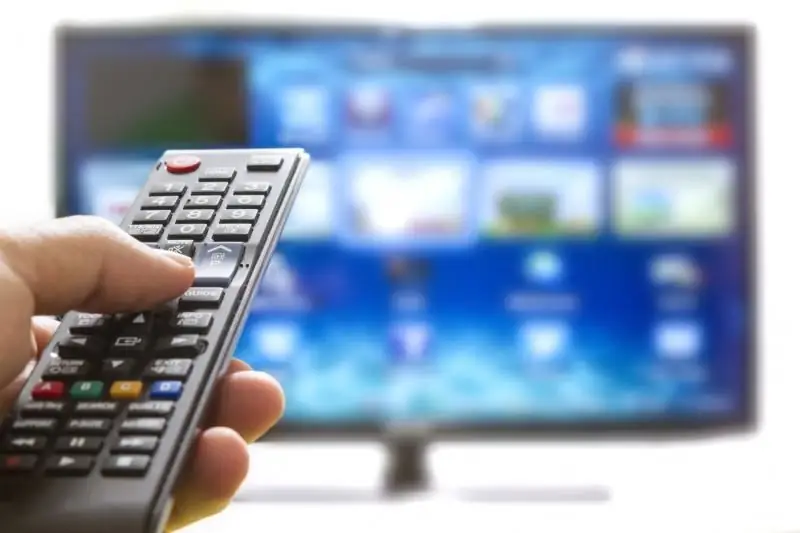
Table of contents:
- Author Bailey Albertson [email protected].
- Public 2023-12-17 12:53.
- Last modified 2025-01-23 12:41.
How to connect a laptop to a TV via Wi-Fi: we use different methods

Many owners of plasma TVs are interested in whether it is possible to connect a laptop or desktop computer to it and, if so, how. The connection can be either wired or wireless. In this article, we will look at the benefits of a wireless connection using Wi-Fi. We will also describe the ways in which you can link two devices.
Content
- 1 What gives connecting a laptop to a TV via Wi-Fi
-
2 How to connect a laptop to a TV via Wi-Fi
-
2.1 Via DLNA connection
- 2.1.1 Video: how to display video from a computer on TV through a DLNA server
- 2.1.2 Enabling Windows Streaming via DLNA
- 2.1.3 Video: Activate Media Streaming in Windows
-
2.2 Via WiDi (Miracast)
2.2.1 Video: turn on the display of the PC screen on the TV via Miracast
- 2.3 Through adapters in the form of a regular flash drive
-
2.4 Using third-party connection utilities
- 2.4.1 Home Media Server Utility
- 2.4.2 Video: how to connect a laptop to Smart TV using the "Home Media Server"
- 2.4.3 Share Manager
- 2.4.4 Serviio Application
-
What gives connecting a laptop to a TV via Wi-Fi
People connect computers to TVs for obvious reasons: it is more pleasant and comfortable to watch videos, films, photographs; playing games, surfing the Internet on a widescreen monitor (TV) with a higher quality than on a relatively small laptop screen. A large diagonal makes the picture more realistic, and the viewer gets much more emotion from viewing and playing.
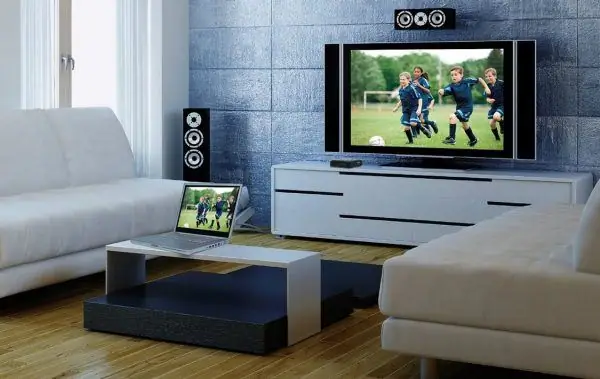
It is much more comfortable to watch a movie or play a game on a big screen, so users often connect laptops to the TV
A wired connection of a laptop to a plasma TV is possible using a special cable called HDMI. After connecting, the TV begins to act as a second monitor, which repeats the image that appears on the laptop screen.
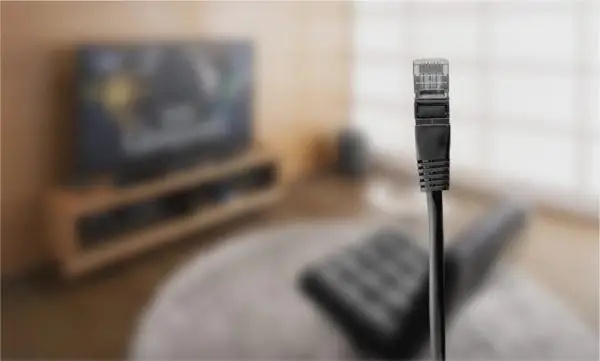
You can connect a laptop to a plasma TV using an HDMI cable
A more modern method is to connect via Wi-Fi. It eliminates the need for users to purchase an HDMI cable and move the laptop closer to the TV for the cable to reach the device. In addition, the absence of wires is aesthetically pleasing to the eye. The downside of wired is that if you catch the cable, you'll have to plug it back in.

You can connect your laptop and TV using your home Wi-Fi network - no need to purchase an HDMI cable
How to connect a laptop to a TV via Wi-Fi
How do I use a Plasma TV as a computer monitor over a wireless connection? There are several ways: you can use both built-in computer and TV tools, and third-party applications.
DLNA connection
DLNA is a technology that allows several devices within the range of one home network (wireless Internet Wi-Fi installed at home) to exchange media files (music, videos, films, etc.) through its network. At the same time, devices can be of different types: tablets, phones, desktop computers, printers, X-boxes, laptops, modern flat TVs (they are equipped with SmartShare functions). In this case, we are interested in the last two types of devices.
For the TV to be able to open files on the laptop, you must open access to them. How to do this, we will tell you with the instructions:
- First, you need to connect both the laptop and the TV to one point on the Internet, that is, to your router. The easiest way to do this on a laptop is to click on the Internet Access icon in the form of a quarter circle.
-
In the list, select the desired network and open it by clicking the left button. Put a tick next to "Connect automatically" and click on "Connect". If necessary, enter the password from the network to gain access to the Internet.

Wi-Fi connection Click on the "Connect" button to connect to the access point
-
Now let's move on to connecting to TV. Let's look at the process using a Samsung TV as an example. Turn on the device and, using the remote control, go to the settings menu. There you need to find the "Network" block (the name of the block may differ depending on the model and manufacturer of the TV). In the right list, select "Network Settings".

Network tab In the "Network" tab, select "Network Settings"
-
Set the network type to "Wireless". The system will find currently available networks. We turn on the point to which the laptop is already connected.

Network settings Set the wireless network type and select the desired access point from the list
-
Returning to your computer: you need to configure a DLNA server on it. This is quite easy to do. We hold down the Win + I key combination to open the Windows Settings window. Here we are interested in the fourth tile "Network and Internet".

Network and Internet tile Choose "Network and Internet" among all tiles
-
In the second Wi-Fi tab, click on the network to which your laptop is already connected.

Wi-Fi tab In the Wi-Fi tab, click on the access point with the left button
-
On the new page, select "Private" as the network profile. We close the window with parameters.

Selecting a network profile Select "Private" for "Network Profile"
-
If your version is lower than "ten", go to "Network and Sharing Center" through the "Control Panel" and set the home (private) network type in the "View active networks" section. It is this kind of connection to the point that allows devices to exchange data.

Network and Sharing Center If you have Windows 7, make your network home (private) in the "Network and Sharing Center"
- Now you need to open one or another directory that the TV can read from the laptop. For example, take the D drive, which usually contains all user files.
-
We go to "Windows Explorer" through the "This computer" icon on the "Desktop". Click on the hard disk D with the right mouse button and in the gray menu click on the last item "Properties".

Hard disk context menu In the context menu of the hard disk, select the "Properties" item
-
We pass directly to the third block "Access". Here we click on the "Advanced settings" button.

Properties window Click on the "Advanced settings" button to open another window
-
In a new small window, put a checkmark to the left of the option "Share this folder". Now click on "Apply" and then on OK.

Advanced customization We mark the item "Share this folder"
-
If you want to open access to all folders on your computer at once, use another method. Start Windows Explorer again. On the left pane of the window, find the "Network" item and click on it. A notification will appear at the top of the window stating that file access has been deactivated. You just need to click on the strip with this message.

Link to open access to folders Click on the blue link "File sharing is disabled"
-
In the list of two items, select "Enable network discovery and file sharing."

Turn on sharing Click on the first item to open file sharing and turn on network discovery
You can also open access to files on a laptop in another way that works for Windows 10:
- Go to the "Network and Internet" section in the "Windows Settings" window, which is launched by the Win + I keyboard shortcut.
-
Here we already need the first tab "State". Scroll it down a bit and click on the "Sharing Options" item.

Status tab Click on the "Sharing Options" section
-
In the new window, put a checkmark next to the items "Enable network discovery" and "Enable file and printer sharing." We then click on the button "Save changes" in the lower right corner of the window.

Change sharing options Turn on network discovery and file sharing on a private network
When access is open, you can take the TV remote and do the following:
- Go to the TV menu, which is responsible for viewing content on external connected devices. For Sony TVs, this is the Home menu, and for LG, this is the SmartShare Utility menu.
-
After that, we select the last item "Connected devices" (the section name differs depending on the model).

SmartShare Go to the "Connected device" section to see the contents of your computer's hard drive
- Select the DLNA server from the list. It will come with the name of the network to which the laptop is connected.
- On the TV screen, you will immediately see the folders that you have on your hard drive.
- Select the file of interest and open it.
- You can also run it on the laptop itself: right-click on the file and select "Play on …" in the list. Then we select our TV to start the broadcast on the big screen.
- You can also open the file on your computer if network discovery of devices has been enabled in the Network and Sharing Center. Find the file in "Windows Explorer" and right-click on it, and then in the gray menu, hover over the item "Play on …". A list of available devices will appear. Select your TV from the list.
Unfortunately, the DLNA system does not include MKV movies. The AVI extension is required. The solution to the problem is to convert the file in a special service.
Video: how to enable display of video from a computer on TV via a DLNA server
Enabling Windows streaming over DLNA
Broadcast video can be displayed on a large TV screen using the standard Windows option "Streaming Media". It also works through a DLNA server, that is, to transfer data, you need to connect to a common Wi-Fi hotspot for both devices. What you need to do to enable the option:
- Open the panel for universal search: by clicking on the magnifying glass icon on the "Taskbar", which should be next to the "Start" button.
-
In the line we start typing the query "Media streaming options". The Windows tool will help you with your search: it will immediately display the desired section in the results as you type the second word in your query. Click on the section with the left mouse button.

Windows Search Enter the query "Media streaming options" in the line
-
In the window that appears, click on the button to enable streaming.

Enabling streaming Click on the button "Enable streaming media"
- After that, all devices that are currently in the home network will have access to the multimedia files. If necessary, you can remove or add certain directories.
-
If you uncheck the Use default settings, you can customize the filters that will apply to a specific device.

Setting streaming options You can configure filters for data transmission for a specific device
-
Now let's look at how to display video on a TV screen. Find the file in Windows Explorer. Click on it with the right mouse button. In the gray menu, select the "Bring to device" option.

Item "Bring to device" Click on "Lead to device" and select your TV
-
First, the standard Windows player will start (or the one that is selected as the default player), where it will be indicated that there is a connection to a network device. After that, the selected file will be broadcast on the TV with Smart TV.

Standard Windows Player A message will appear in the Windows player stating that it is connecting to a network device
-
The option is also available in the "Kino i TV" player. In its window there is a special icon in the form of a display and a Wi-Fi icon in its right corner.

Player "Cinema and TV" In the "Movies and TV" player, you can also enable video broadcast on the TV screen
Video: Activate Media Streaming in Windows
Using WiDi (Miracast)
Another effective method of transferring data from a laptop to a TV with Smart TV is WiDi technology (its other name is Miracast). This system is developed by Intel. It consists in projecting an image from a computer screen on a TV display, that is, it is not just a file transfer (for example, using a DLNA server), but a full-fledged display on a TV screen of what is happening on a laptop monitor, including moving the mouse, launching folders and etc.
WiDi (Wi-Fi Direct) allows you to transfer surround sound effect and full-length video. This data transfer does not require a Wi-Fi hotspot. In this case, you only need to support Miracast technology on both devices.
Previously, to configure WiDi, you had to download the utility from the official Intel website. Now the company has stopped releasing updates for it and deleted all files for download, since the application is now embedded in Windows 10 and 8. Thus, all manipulations will be performed in the TV and laptop settings themselves:
- First of all, you need to activate the Miracast option on your TV. Menus, chapters and, accordingly, the activation procedure will differ depending on the model. For example, let's take an LG TV and a Windows 10-based computer. On the TV, look for the Smart TV section, and in it the Connection Manager.
-
In it, open the "Personal Computer" block, and then the "Screen Sharing" tile.

Connection manager Select the "Personal Computer" section in the "Connection Manager"
- In the list on the left, select Miracast. On the right there will be a blue Start button. We press immediately on it. The TV will then be ready to connect to your laptop.
-
On other TV models, the Miracast function can be enabled in the settings themselves, in particular, in the "Network" section.

Miracast item in the "Network" section Turn on the Miracast option through the "Network" section in the TV settings
-
Sections can also be called Screen Mirroing or Screen Share.

Screen Share You can enable Miracast through the built-in Screen Share menu on some TV models
- If you can't find a section for this option, you might not have it. In this case, you can try to simply turn on Wi-Fi on the device.
- Now all the following steps must be performed on a laptop. Hold down the Win + P keyboard shortcut. The command will launch the Project panel on the right side of the screen.
-
If the combination does not work, click on the "Notification Center" icon, which is located on the right side of the "Taskbar", or hold down another Win + A combination.

Notification Center Icon Click on the "Notification Center" icon, which is located on the right side of the "Taskbar"
-
Among the tiles, look for "Send to Screen" and click on it.

Notification Center Find the tile called "Send to Screen" and click on it
-
On the new panel, click on the link below "Connect to a wireless display".

Project panel Click on the link below "Connect to a wireless display"
-
The process of searching for devices will begin. Wait a while. As a result, your TV should appear on the list. Choose it.

Find Wireless Displays Wait while the system finds currently available displays
- After a few seconds, you will see the laptop screen appear on the TV.
You can search for a TV on a laptop for further connection to it in a slightly different way:
- On the keyboard, hold down the simple Win + I combination so that the Windows Settings window opens on the screen.
-
If it does not work on your device, go to the same window using the "Start": click on the icon in the form of a gear.

Start Menu Click on the "Options" button in the "Start" menu to open the window for settings
-
Select the tile called "Devices".

Devices tile Select the second "Devices" tile
-
In the first tab, click on the "Add Bluetooth or other device" option.

Bluetooth tab and other devices Click on the option "Add Bluetooth or other device"
-
In the black new window, click on the second item "Wireless display or docking station".

Add a device in a new window In the black window, click on "Wireless display or docking station"
-
We are waiting for the search to complete and make a choice in favor of our TV in order to connect to it.

Finding a device in a black window Wait while the system finds your TV
Video: turn on the display of the PC screen on the TV via Miracast
Through adapters in the form of a regular flash drive
Don't be in a hurry to get upset if your TV doesn't have a Wi-Fi module. You can still connect your laptop or other device to it wirelessly if you have an HDMI port. A special adapter or micro-PC, which looks like a flash drive, will help you with this.
The most popular models are as follows:
- Android Mini PC;
- Google Chromecast;
- Miracast adapter;
- Intel Compute Stick.
The devices significantly expand the functionality of an outdated TV device. The main function of Google Chromecast, for example, is to play videos of various formats from a PC on a TV, and a Miracast adapter is to duplicate the picture itself from a laptop display. The most important thing when choosing this small but useful device is to make sure that the TV will work with it. To do this, you will need to consult with the seller.
Using third-party utilities to connect
You can connect the two devices using third-party applications that work mainly on the DLNA system. Programs open a specific TV access to certain files and folders. Their list, as well as the device that will access the content, is determined by the user himself in the application window.
Home Media Server Utility
This free application is suitable for models of almost all manufacturers. Its developer is Evgeny Lachinov. Where to download the utility and how to use it? We will tell you in detail in the instructions:
-
We open the official website of the utility. Click on the blue "Download" button. If you do not want to download and unpack then the archive, click on the first button.

Official site of "Home Media Server" Click on the first Download button to download the program installer
-
We launch the newly downloaded installer. In the first field, select the directory where the application will be installed. Click on "Run".

Run button Select the folder in which the program should be saved and click on "Run"
-
If necessary, put a tick next to "Create a shortcut to launch the program". After that, click on "Install".

Program installation To start the installation, click on the "Install" button
- Make sure both laptop and TV are connected to the same Wi-Fi hotspot before proceeding. If not, connect, otherwise you will not see the files on the TV list.
-
We open the program. In its window, click on the fifth icon "Settings".

Utility window Click on the "Settings" icon on the top panel of the window
-
In the "Devices" section in the drop-down menu, select your TV. Click on OK.

Devices tab In the drop-down menu, find your TV and click on it
-
Go to the first tab "Media Resources". Here you need to select the folders that will be shown to the TV device.

Media Resources Tab In the "Media resources" tab, click on the "Add" button
-
To do this, click on the "Add" button on the right with a big green plus. Select the directory and click on OK.

Directory selection Select the folder or hard drive you want to add to the list
- After all directories with media content are selected, click on "Start" to turn on the DLNA server.
- Now you can open available files on TV.
Video: how to connect a laptop to Smart TV using the "Home Media Server"
Share Manager
This program is suitable for you only if you use a Samsung TV. The utility developer is the same company. The utility also works on the basis of the DLNA standard and allows you to view the contents of laptop hard drives on a widescreen TV display. The program requires a connection to either Wi-Fi or Ethernet wired internet.
The app is suitable for Windows versions such as 10, 8, 7, Vista and XP. It is compatible with all generations of TV devices that support DLNA.
How to use the utility, we will tell you in the detailed instructions:
- First, make sure your computer and TV are connected to the same Wi-Fi network.
- The utility is available for download on the official Samsung website, so go to it and download the program. The installer weighs about 52 MB. We launch it and install the application on the laptop.
-
In the window of the open utility on the left we will see a panel similar to "Windows Explorer". In it we find folders that contain media files for playback.

Share Manager window On the left side of the window, find the folders with the files that you want to play on the TV
-
Then drag the folders to the right side of the window. Alternatively, right-click on the folder and select the first option, "Share this folder".

Item "Share folder" Right-click on the folder and select "Share this folder"
- On the top panel, click on the item "Sharing", and then in the menu that appears, click on "Set device policy".
-
A list with available devices will start over the main window. We select the necessary ones using the "Accept" buttons. Click on OK.

Setting device policy Click on the "Accept" button to the right of the device that you want to grant access to files
- After that, click on the "Sharing" section again. We select the third option "Set changed state".
- We are waiting for the update to complete. After that, all changes made on the PC will take effect.
- We turn to the TV. Go to TV Sources and click on PC Share Manager. Select the Share Folder. The catalogs from the laptop will appear on the display. Find the file you want and open it.
Serviio app
Serviio is a free utility in Russian for creating a DLNA channel. Its interface has been translated into Russian. It is quite simple: even a novice user will understand the setup.
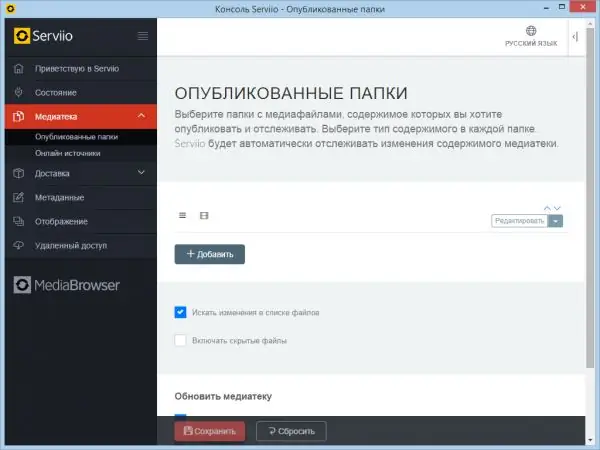
In Serviio, you can add specific media folders to share
What are the benefits of the program?
- Automatic updating of the media library.
- Providing video broadcast to various devices.
- An easy way to create a home LAN.
- Support for plugins for playing videos from non-standard sources.
The developer of the program is the Media Streaming Server company. The utility has the following minimum requirements for a computer:
- RAM - 512 MB.
- Free disk space - 150 MB.
- Operating system - Windows, Linux, OSX.
The application is available for download on the official website.
If you don't have a cable called HDMI, but want to connect your laptop to a flat screen TV, use the wireless methods of these two devices. You can simply display the broadcast of a video through a classic DLNA server, or set up a full copy of the picture from a laptop on a TV screen via Miracast technology. If your TV does not connect to Wi-Fi and does not support the Miracast (WiDi) standard, purchase a special adapter that will help you set up communication between your computer and TV.
Recommended:
How To Connect The Music Center To A TV, Computer, Laptop And Other Devices + Video
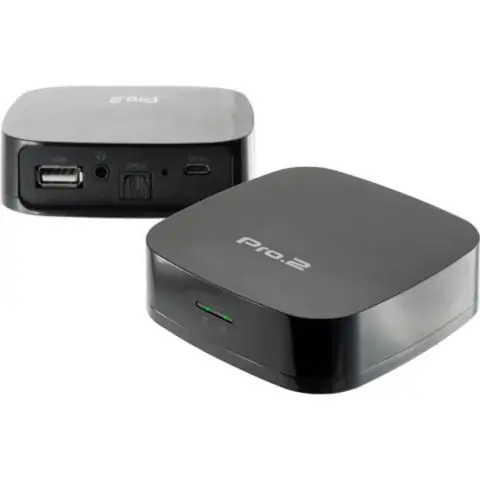
How to connect the music center to a computer, laptop, TV. What are the cables and connectors, how to connect the wires correctly
How To Connect An IPhone, IPad To A TV Via Wi-Fi, USB
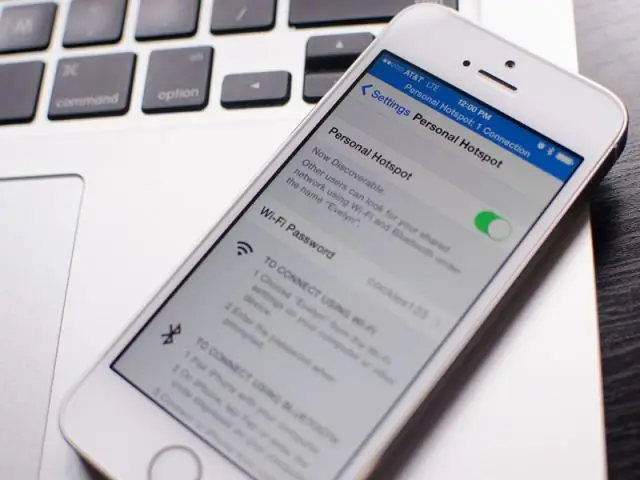
How to connect Apple appliances to a TV. Use of official adapters and third party products. Possible connection errors
How To Connect A TV To A Computer Via WIFI: Connect And Broadcast Video With Images
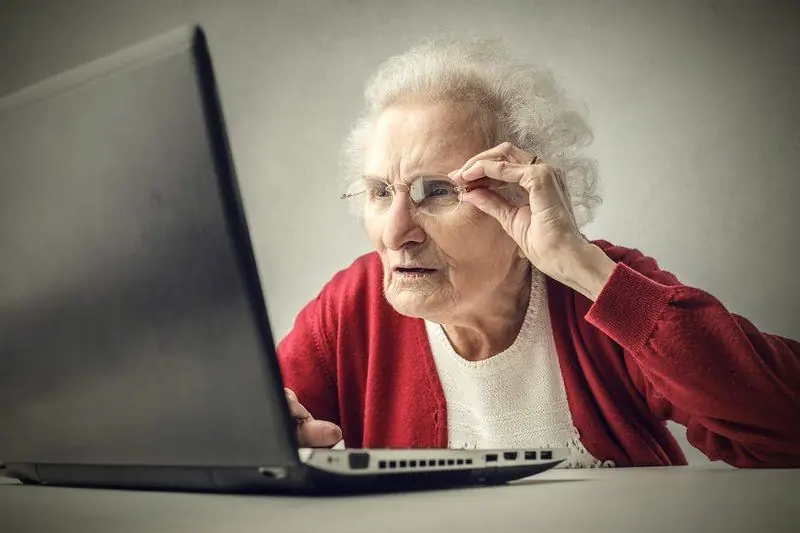
How to connect a TV to a computer via Wi-Fi: connecting a TV with a smart TV function or a regular one. Instructions with illustrations and videos
How To Connect A Phone Or Tablet To A TV Via WiFi

Several ways to connect your phone or tablet to TV. How to run a file from a phone on a TV or start controlling a TV using a phone (like a remote control)
Why The Phone Does Not Connect To WiFi And What To Do About It: Detailed Instructions For Solving The Problem
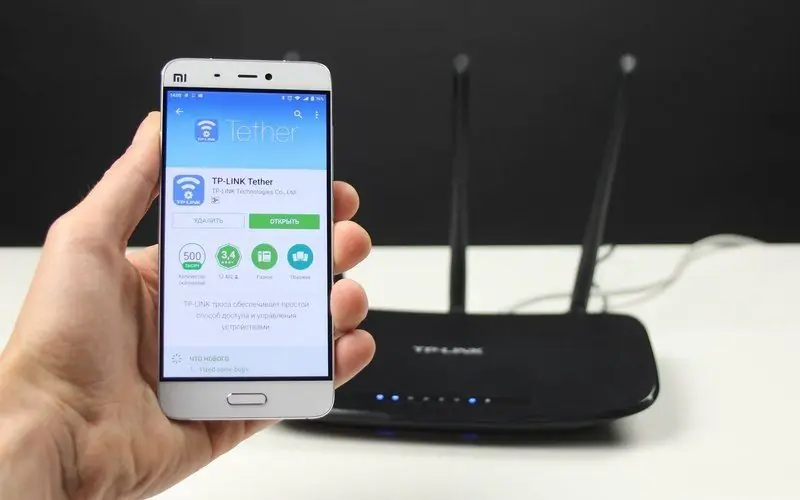
The reasons why the smartphone cannot connect to the wireless Internet network. Analysis and solution of all problems with photo and video instructions
